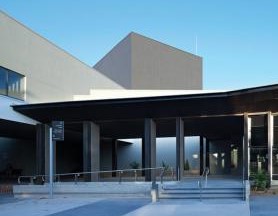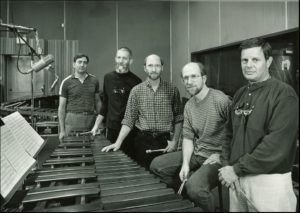 #NEXUSat50 1986 RARE INSTRUMENTS FOR GEORGE HAMILTON GREEN – with sound bytes: Between an Australian tour, Expo86 World Drums, Kennedy Center with Sharda Sahai (PASIC86) and a week-long tour of Tennessee, we found time to go into McClear Place in Toronto (photo attached) and record THE NOVELTY MUSIC OF GEORGE HAMILTON GREEN. Bob Becker says, “In that photo we’re posing behind my five-octave Deagan #268 xylophone – a very rare instrument that lent its unique low register sound to The Humming Bird. For that session we borrowed [future NEXUS member] Garry Kvistad’s equally rare five-octave Deagan Nabimba, an instrument with a range to low cello C, and with buzzing membranes added to the resonators in the fashion of Guatemalan and Mexican marimbas. In today’s digital electronic world it’s rare to find recordings that are not highly processed, edited and even over-dubbed. On this recording, Green’s “Charleston Capers” was done in one continuous take, as were a few other pieces on that CD. I always felt good when we recorded this kind of music in one take, because that was the way it had to be done by G.H. Green himself during the acoustic recording era when he was most prolific. The recording technology at the time (around 1915 through 1925) was entirely mechanical, using no electrical components or microphones – the original direct-to-disc method.” You can hear “Charleston Capers” in Bob’s blog post at https://bit.ly/2VmYIT4 . (While there, you can give a listen to “Triplets” from our 1976 Direct-To-Disc NEXUS RAGTIME CONCERT.) You can hear “Fluffy Ruffles” from our 1986 recording at https://bit.ly/3ig8sbc and you can see and hear NEXUS performing “Jovial Jasper” at Expo86 on YouTube at https://bit.ly/2DIgISn
#NEXUSat50 1986 RARE INSTRUMENTS FOR GEORGE HAMILTON GREEN – with sound bytes: Between an Australian tour, Expo86 World Drums, Kennedy Center with Sharda Sahai (PASIC86) and a week-long tour of Tennessee, we found time to go into McClear Place in Toronto (photo attached) and record THE NOVELTY MUSIC OF GEORGE HAMILTON GREEN. Bob Becker says, “In that photo we’re posing behind my five-octave Deagan #268 xylophone – a very rare instrument that lent its unique low register sound to The Humming Bird. For that session we borrowed [future NEXUS member] Garry Kvistad’s equally rare five-octave Deagan Nabimba, an instrument with a range to low cello C, and with buzzing membranes added to the resonators in the fashion of Guatemalan and Mexican marimbas. In today’s digital electronic world it’s rare to find recordings that are not highly processed, edited and even over-dubbed. On this recording, Green’s “Charleston Capers” was done in one continuous take, as were a few other pieces on that CD. I always felt good when we recorded this kind of music in one take, because that was the way it had to be done by G.H. Green himself during the acoustic recording era when he was most prolific. The recording technology at the time (around 1915 through 1925) was entirely mechanical, using no electrical components or microphones – the original direct-to-disc method.” You can hear “Charleston Capers” in Bob’s blog post at https://bit.ly/2VmYIT4 . (While there, you can give a listen to “Triplets” from our 1976 Direct-To-Disc NEXUS RAGTIME CONCERT.) You can hear “Fluffy Ruffles” from our 1986 recording at https://bit.ly/3ig8sbc and you can see and hear NEXUS performing “Jovial Jasper” at Expo86 on YouTube at https://bit.ly/2DIgISn
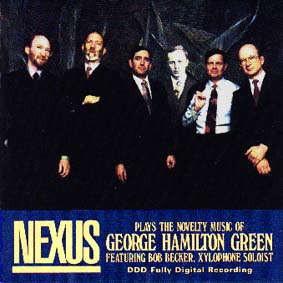
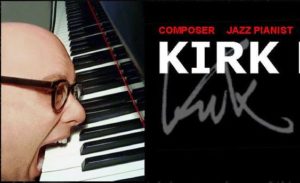 #NEXUSat50 1986 NEXED RHAPSODY The year had brought us a number of new commissioned works. Toronto’s New Music Concerts commissioned John Hawkins who wrote “substance-of-we-feeling” for 2 percussionists. The name comes from Doris Lessing’s sci-fi book “Shikasta”. Bruce Mather wrote a new piece, again named for a fine wine, “Clos d’Audignac”. Bob: Becker says, “In my opinion, there’s a connection between drinking a fine wine and listening to one of Bruce’s pieces. You have to wallow in it.” And from Kirk Nurock came “Nexed Rhapsody”. Russell tells us, “Kirk Nurock is a composer and jazz pianist who worked with a number of the great jazz artists including Dizzy Gillespie, Chet Baker, and Phil Woods. He also was accompanist for Billy Eckstine and Cab Calloway in the Catskill Mountains. In the 1970s, Kirk formed the Natural Sound Workshop, an innovative vocal technique group that often featured Jay Clayton. Jay is one of the original singers in the Steve Reich and Musicians ensemble and she introduced me to Kirk at one of our concerts in New York City. A few years later, Kirk composed the music for a theatre production that toured to Toronto, and he asked me to play percussion in the small pit band for the play. During the run of the show, I asked Kirk if he would write a piece for Nexus and the result is the beautiful NEXED RHAPSODY.” Keyboard magazine calls Kirk “joyously iconoclastic”. He composed a work for 20 voices and 3 canines which he conducted at Carnegie Hall, and won a scholarship at age 16, awarded by Duke Ellington. The New York Times says, “Mr. Nurock has unique credentials.” The year before he wrote “Nexed Rhapsody” for us, Kirk had composed a jazz musical, Mowgli (based on Kipling’s Jungle Books). The score blended jazz harmonies, scat singing, animal sounds, Broadway melodies and world-music elements. A couple years after “Nexed Rhapsody” he wrote another large-scale work, “Listening Back”, for orchestra, chorus, narrator, four canines and eight guinea pigs! You will enjoy reading more at https://kirknurock.com/
#NEXUSat50 1986 NEXED RHAPSODY The year had brought us a number of new commissioned works. Toronto’s New Music Concerts commissioned John Hawkins who wrote “substance-of-we-feeling” for 2 percussionists. The name comes from Doris Lessing’s sci-fi book “Shikasta”. Bruce Mather wrote a new piece, again named for a fine wine, “Clos d’Audignac”. Bob: Becker says, “In my opinion, there’s a connection between drinking a fine wine and listening to one of Bruce’s pieces. You have to wallow in it.” And from Kirk Nurock came “Nexed Rhapsody”. Russell tells us, “Kirk Nurock is a composer and jazz pianist who worked with a number of the great jazz artists including Dizzy Gillespie, Chet Baker, and Phil Woods. He also was accompanist for Billy Eckstine and Cab Calloway in the Catskill Mountains. In the 1970s, Kirk formed the Natural Sound Workshop, an innovative vocal technique group that often featured Jay Clayton. Jay is one of the original singers in the Steve Reich and Musicians ensemble and she introduced me to Kirk at one of our concerts in New York City. A few years later, Kirk composed the music for a theatre production that toured to Toronto, and he asked me to play percussion in the small pit band for the play. During the run of the show, I asked Kirk if he would write a piece for Nexus and the result is the beautiful NEXED RHAPSODY.” Keyboard magazine calls Kirk “joyously iconoclastic”. He composed a work for 20 voices and 3 canines which he conducted at Carnegie Hall, and won a scholarship at age 16, awarded by Duke Ellington. The New York Times says, “Mr. Nurock has unique credentials.” The year before he wrote “Nexed Rhapsody” for us, Kirk had composed a jazz musical, Mowgli (based on Kipling’s Jungle Books). The score blended jazz harmonies, scat singing, animal sounds, Broadway melodies and world-music elements. A couple years after “Nexed Rhapsody” he wrote another large-scale work, “Listening Back”, for orchestra, chorus, narrator, four canines and eight guinea pigs! You will enjoy reading more at https://kirknurock.com/
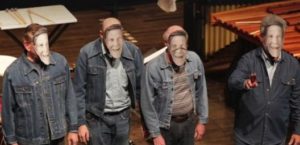 #NEXUSat50 1987 JOHN CAGE’s BIRTHDAY IN L.A. We were invited to participate in Cage’s 75th birthday celebration as a part of his MUSICIRCUS, a 3-hour “happening” with 90 performances and Cage himself as one of the many performers. While we played various pieces (including Third Construction several times at precise moments), there were other performances, readings and narration taking place – all in a large open room while the audience moved freely among the performers. Bill says that “while the effect was seemingly random, the entire sequence…was entirely worked-out in a single page score.” Bob says, “My experience has been that those shows where Cage was involved personally were orders of magnitude more powerful, persuasive and exciting compared to concerts of his music without his presence. He had a way of encouraging performers to listen to every sound – in fact, to perceive every event – with the kind of focused attention he wanted. I recall the 1987 rehearsal in LA where he spent quite a bit of time working with one of the performers on achieving the correct approach to running water from a garden hose into a child’s inflatable swimming pool.” Robin was asked to play in “but what about the noise of crumpling paper etc.” (written in 1982), and wrote, “I believe John prided himself on his clarity of expression. He approached me during the first rehearsal and complained about my not playing the way he had explained in his performance note. He was, for Cage, quite exercized and I was apologetic. I told him I had read his note and was conscientiously playing as I had understood it. He told me what he wanted and that was that. After the evening performance John approached and said, ‘You were correct. I reread my note and there was a misplaced comma which I have moved to its proper place.’ Alas, I never asked him to show me the revision!” Bill performed with Cage in Cage ’s piece “Inlets” and remembers “an ensemble consisting of several conch shell trumpets. Cage had an enormous conch shell – about 24-inches long – into which water was added. A contact mic amplified the sounds of the water flowing between the inner chambers of the shell producing deep gurgles and bubbly high sounds. I was to play a conch trumpet in the ensemble ‘at some time after the halfway point of each’ of the three performances. The chance entrances of Cage’s amplified gurgling sounds were absolutely hilarious…I laughed so much I could hardly breathe.” Russell recalls that Cage had suggested, for the program booklet, “a collection of remarks from friends and colleagues, laid out like a music score with different typefaces for each person.” The NEXUS contribution to the booklet, titled “Twenty-One Pages for John Cage” was a collection of “Yorkers” – those infamous aphorisms we had collected during our 1973 York University residency. Cage himself conducted the performance of the booklet at MUSICIRCUS. Here are Yorker contributions: We need some definitions/All of these are various ways of saying the same thing/ There’s only one pitch/Every rhythm can be felt by the body/You have to think slow to play fast/If you go by ear, you won’t be off/You’re always doing it the right way/If you can understand it, it’s not worth doing/The foremost thing you want to do is smile/If you are considering, you’re not doing/The less interested we become in MUSIC the better we’ll play/Take this and practice it until you can’t play it/What happened to the concert before we get into anything else…forget it/Take whatever you want/It’s even better on tape/We can always hear if we listen/Now that we’re here…Where are we?/When you ‘ve institutionalised it, you’ve lost it/The concept of time is irrelevant when you’re playing time/I don’t think you have to worry about what we were just talking about. (No photo from MUSICIRCUS’87, but the one above is NEXUS at Bard College, compliments of The John Cage Trust!)
#NEXUSat50 1987 JOHN CAGE’s BIRTHDAY IN L.A. We were invited to participate in Cage’s 75th birthday celebration as a part of his MUSICIRCUS, a 3-hour “happening” with 90 performances and Cage himself as one of the many performers. While we played various pieces (including Third Construction several times at precise moments), there were other performances, readings and narration taking place – all in a large open room while the audience moved freely among the performers. Bill says that “while the effect was seemingly random, the entire sequence…was entirely worked-out in a single page score.” Bob says, “My experience has been that those shows where Cage was involved personally were orders of magnitude more powerful, persuasive and exciting compared to concerts of his music without his presence. He had a way of encouraging performers to listen to every sound – in fact, to perceive every event – with the kind of focused attention he wanted. I recall the 1987 rehearsal in LA where he spent quite a bit of time working with one of the performers on achieving the correct approach to running water from a garden hose into a child’s inflatable swimming pool.” Robin was asked to play in “but what about the noise of crumpling paper etc.” (written in 1982), and wrote, “I believe John prided himself on his clarity of expression. He approached me during the first rehearsal and complained about my not playing the way he had explained in his performance note. He was, for Cage, quite exercized and I was apologetic. I told him I had read his note and was conscientiously playing as I had understood it. He told me what he wanted and that was that. After the evening performance John approached and said, ‘You were correct. I reread my note and there was a misplaced comma which I have moved to its proper place.’ Alas, I never asked him to show me the revision!” Bill performed with Cage in Cage ’s piece “Inlets” and remembers “an ensemble consisting of several conch shell trumpets. Cage had an enormous conch shell – about 24-inches long – into which water was added. A contact mic amplified the sounds of the water flowing between the inner chambers of the shell producing deep gurgles and bubbly high sounds. I was to play a conch trumpet in the ensemble ‘at some time after the halfway point of each’ of the three performances. The chance entrances of Cage’s amplified gurgling sounds were absolutely hilarious…I laughed so much I could hardly breathe.” Russell recalls that Cage had suggested, for the program booklet, “a collection of remarks from friends and colleagues, laid out like a music score with different typefaces for each person.” The NEXUS contribution to the booklet, titled “Twenty-One Pages for John Cage” was a collection of “Yorkers” – those infamous aphorisms we had collected during our 1973 York University residency. Cage himself conducted the performance of the booklet at MUSICIRCUS. Here are Yorker contributions: We need some definitions/All of these are various ways of saying the same thing/ There’s only one pitch/Every rhythm can be felt by the body/You have to think slow to play fast/If you go by ear, you won’t be off/You’re always doing it the right way/If you can understand it, it’s not worth doing/The foremost thing you want to do is smile/If you are considering, you’re not doing/The less interested we become in MUSIC the better we’ll play/Take this and practice it until you can’t play it/What happened to the concert before we get into anything else…forget it/Take whatever you want/It’s even better on tape/We can always hear if we listen/Now that we’re here…Where are we?/When you ‘ve institutionalised it, you’ve lost it/The concept of time is irrelevant when you’re playing time/I don’t think you have to worry about what we were just talking about. (No photo from MUSICIRCUS’87, but the one above is NEXUS at Bard College, compliments of The John Cage Trust!)
Read more at the Cage Compositions Chronology at https://cagecomp.home.xs4all.nl/chronology_1972-1992.html A John Cage Compendium: Chronology 1972-1992
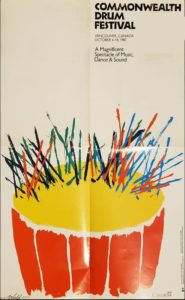 #NEXUSat50 1987 COMMONWEALTH DRUM FESTIVAL John Wyre was not one to rest on his laurels. The 5-day Commonwealth Drum Festival (again in Vancouver, 15 months after Expo86) “was a great leap forward,” he said. At Expo86, because of all the performances at the many other pavilions, “We didn’t get to know each other well enough. We didn’t get to hear each other well enough. We didn’t spend enough time together ourselves. That was a lesson.” The finale concert at Expo86 had left everyone wanting more of that wonderful inter-connection. Happily, for the Commonwealth event, John wrote, “We had more time to work together to combine our traditions and we opened up a lot more. There was improved communication between the artists which enabled us to work together in a more efficient way.” Eighty artists came together to herald the Commonwealth Heads of Government biennial summit, the first time it had been in Canada since 1973. “New” performers were the Hunt Family (Kwakiutl Drums and Dancers from British Columbia), the Australian duo Australis (Ron Reeves, and Colin Offord who had created several new and spectacular mouth-bows), Canada’s Triumph Street Pipe & Drum Band, the Kelaniya Free Lancers from Sri Lanka, and the Vancouver-based “African Heritage” quartet of Albert St.Albert and Govind Dido, along with Themba Tana and Sal Ferreras who had been part of Expo86. Other “return” artists were Lapo Kabwit (St Lucia), Harmonites (Antigua), Bomas of Kenya, NEXUS, Trichy Sankaran, Sharda Sahai, and Abraham Adzenyah. Abraham has recently retired (2016) from 45 years of teaching at Wesleyan U. in Middletown Connecticut. He is such a revered teacher that students and alumni were able to create a $300,000 endowed Wesleyan scholarship fund in his name and Wesleyan has named its rehearsal hall in the Center for the Arts in his honour. (Photo: A scenes from the Commonwealth Drum Festival.)
#NEXUSat50 1987 COMMONWEALTH DRUM FESTIVAL John Wyre was not one to rest on his laurels. The 5-day Commonwealth Drum Festival (again in Vancouver, 15 months after Expo86) “was a great leap forward,” he said. At Expo86, because of all the performances at the many other pavilions, “We didn’t get to know each other well enough. We didn’t get to hear each other well enough. We didn’t spend enough time together ourselves. That was a lesson.” The finale concert at Expo86 had left everyone wanting more of that wonderful inter-connection. Happily, for the Commonwealth event, John wrote, “We had more time to work together to combine our traditions and we opened up a lot more. There was improved communication between the artists which enabled us to work together in a more efficient way.” Eighty artists came together to herald the Commonwealth Heads of Government biennial summit, the first time it had been in Canada since 1973. “New” performers were the Hunt Family (Kwakiutl Drums and Dancers from British Columbia), the Australian duo Australis (Ron Reeves, and Colin Offord who had created several new and spectacular mouth-bows), Canada’s Triumph Street Pipe & Drum Band, the Kelaniya Free Lancers from Sri Lanka, and the Vancouver-based “African Heritage” quartet of Albert St.Albert and Govind Dido, along with Themba Tana and Sal Ferreras who had been part of Expo86. Other “return” artists were Lapo Kabwit (St Lucia), Harmonites (Antigua), Bomas of Kenya, NEXUS, Trichy Sankaran, Sharda Sahai, and Abraham Adzenyah. Abraham has recently retired (2016) from 45 years of teaching at Wesleyan U. in Middletown Connecticut. He is such a revered teacher that students and alumni were able to create a $300,000 endowed Wesleyan scholarship fund in his name and Wesleyan has named its rehearsal hall in the Center for the Arts in his honour. (Photo: A scenes from the Commonwealth Drum Festival.)
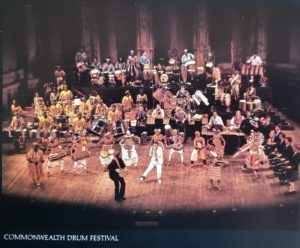
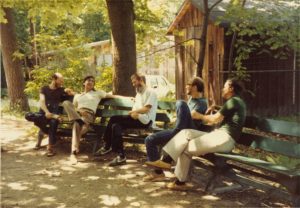 #NEXUSat50 1987 QUOTES AND GIRLFRIENDS We had our second solo appearance at Tanglewood in Summer ’87. Our first time had been back in ’82. We performed in the small shed and here is one of our favorite photos of the 5 of us “hanging out” behind the shed. Percussioner International magazine in November ’87 ran an issue that had two feature articles, one on World Drums and another detailing “NEXUS on Tour”, as well as excerpts from a NEXUS improvisation and seminar that ran with large photos and quotes. Bob Becker brought in some new repertoire in the form of his Girlfriends Medley which he created as an homage to Sammy Herman, one of the greatest xylophone virtuosos of the 1920s/30s. The three songs included in the arrangement were all major “hits” during the 1920’s. The first is Margie, written by Con Conrad and Russel Robinson with lyrics by Benny Davis. Second is Jean, words and music both written by the popular Canadian song-writer Shelton Brooks who was famous for such other hits as Some of These Days and The Darktown Strutters Ball. The final song is Dinah, by Harry Akst with lyrics by Sam Lewis and Joe Young. When we finally recorded the arrangement in 2003, it was another one-take recording. Bob says, “Music like this, where continuous improvisation is a major part of the performance, kind of demands that approach. Although some extraneous noise and unintended sounds have to be left in the mix, the feeling of spontaneity in the music overrides all of that.” You can listen to it by scrolling down in Bob’s blog post at: https://bit.ly/2VmYIT4
#NEXUSat50 1987 QUOTES AND GIRLFRIENDS We had our second solo appearance at Tanglewood in Summer ’87. Our first time had been back in ’82. We performed in the small shed and here is one of our favorite photos of the 5 of us “hanging out” behind the shed. Percussioner International magazine in November ’87 ran an issue that had two feature articles, one on World Drums and another detailing “NEXUS on Tour”, as well as excerpts from a NEXUS improvisation and seminar that ran with large photos and quotes. Bob Becker brought in some new repertoire in the form of his Girlfriends Medley which he created as an homage to Sammy Herman, one of the greatest xylophone virtuosos of the 1920s/30s. The three songs included in the arrangement were all major “hits” during the 1920’s. The first is Margie, written by Con Conrad and Russel Robinson with lyrics by Benny Davis. Second is Jean, words and music both written by the popular Canadian song-writer Shelton Brooks who was famous for such other hits as Some of These Days and The Darktown Strutters Ball. The final song is Dinah, by Harry Akst with lyrics by Sam Lewis and Joe Young. When we finally recorded the arrangement in 2003, it was another one-take recording. Bob says, “Music like this, where continuous improvisation is a major part of the performance, kind of demands that approach. Although some extraneous noise and unintended sounds have to be left in the mix, the feeling of spontaneity in the music overrides all of that.” You can listen to it by scrolling down in Bob’s blog post at: https://bit.ly/2VmYIT4
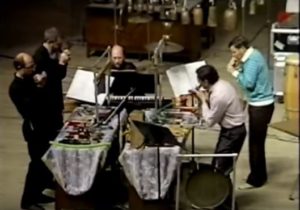 #NEXUSat 50 1988 FAMILY FUN WITH ORCHESTRAS We were in the USA for several university dates in 1988: Kansas, Nebraska, Florida, Connecticut. In Wisconsin at the Peninsula Music Festival in Fish Creek we performed our first ever “From Rags to Riches” concert with Victor Yampolsky (who just in 2019 stepped down after 34 seasons at the Festival!) The program featured music from Bill Cahn’s Rochester Theater Orchestra library along with Bill’s arrangements for small orchestra, all with NEXUS as soloists. At the Blossom Music Center with the Cleveland Orchestra under Jahja Ling, we performed Wyre’s “Connexus” and Cahn’s “The Birds”. Gone were the days of being a solo act sandwiched between two orchestral works! Perhaps it was all this stateside touring that inspired Bob Becker’s 1988 arrangement, “States Medley”. In it he presents three of the most popular ones written during the 1920s: Indiana, by James F. Hanley with lyrics by Ballard MacDonald; Alabamy Bound, by Ray Henderson with lyrics by Bud DeSylva and Bud Green; and California Here I Come, words and music by Al Jolson, Bud DeSylva and Joseph Meyer. By 1988, Bill Cahn had developed another family concert, “World of Drumming” (the precursor to our “Story of Percussion” program) and we enjoyed performing it with the Buffalo Philharmonic under Michael Stern, the Kingston (Ontario) Symphony under Brian Jackson, and the following year with the Toronto Symphony under the late and loved Errol Gay, and a full SIX performances with the National Arts Centre Orchestra (Ottawa) with our staunch supporter from our early days, Boris Brott. Read more about Bill’s theatre orchestra library at https://www.nexuspercussion.com/2018/11/tale-of-a-library/. That library is now with the the Peacherine Ragtime Society Orchestra.
#NEXUSat 50 1988 FAMILY FUN WITH ORCHESTRAS We were in the USA for several university dates in 1988: Kansas, Nebraska, Florida, Connecticut. In Wisconsin at the Peninsula Music Festival in Fish Creek we performed our first ever “From Rags to Riches” concert with Victor Yampolsky (who just in 2019 stepped down after 34 seasons at the Festival!) The program featured music from Bill Cahn’s Rochester Theater Orchestra library along with Bill’s arrangements for small orchestra, all with NEXUS as soloists. At the Blossom Music Center with the Cleveland Orchestra under Jahja Ling, we performed Wyre’s “Connexus” and Cahn’s “The Birds”. Gone were the days of being a solo act sandwiched between two orchestral works! Perhaps it was all this stateside touring that inspired Bob Becker’s 1988 arrangement, “States Medley”. In it he presents three of the most popular ones written during the 1920s: Indiana, by James F. Hanley with lyrics by Ballard MacDonald; Alabamy Bound, by Ray Henderson with lyrics by Bud DeSylva and Bud Green; and California Here I Come, words and music by Al Jolson, Bud DeSylva and Joseph Meyer. By 1988, Bill Cahn had developed another family concert, “World of Drumming” (the precursor to our “Story of Percussion” program) and we enjoyed performing it with the Buffalo Philharmonic under Michael Stern, the Kingston (Ontario) Symphony under Brian Jackson, and the following year with the Toronto Symphony under the late and loved Errol Gay, and a full SIX performances with the National Arts Centre Orchestra (Ottawa) with our staunch supporter from our early days, Boris Brott. Read more about Bill’s theatre orchestra library at https://www.nexuspercussion.com/2018/11/tale-of-a-library/. That library is now with the the Peacherine Ragtime Society Orchestra.
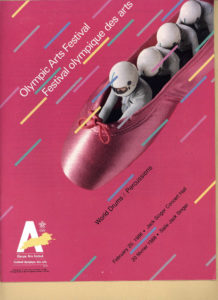 #NEXUSat50 1988 GLOBE-HOPPING PART ONE: THE OLYMPICS and TOKYO MUSIC JOY The year began at the winter Olympics arts festival in Calgary, Canada, a perfect opportunity for World Drums. The “heartbeat” this time was Ed Thigpen, of whom John Wyre wrote, “Ed’s work with Oscar Peterson had lit a fire in me that burns to this day.” Another new addition was the amazing Jamey Haddad playing his ceramic self-designed Hadgini. Many familiar faces returned (Adzenyah, African Heritage, Samul-Nori, NEXUS and Sharda Sahai) and also Glen Velez and Trichy Sankaran. Of Glen, John wrote, “He has set an example for all artists, the example of integrity and discipline and following your own curiosity. Glen’s music brings the world together.” Of Trichy, John wrote. “He is simply one of the most powerful musicians I have ever worked with. The reverence in this man for his art is palpable.…Place Sankaran on a stage with any number of great musicians and he will kick everyone’s butt and they will all love the experience.” The Calgary Herald said, “World Drums was nothing short of an exhilarating trip through the most primal and possibly pure form of non-verbal communication…It was a communal celebration that captured the true international spirit of the Olympics.” From there we flew to “Tokyo Music Joy” produced by Toru Takemitsu. Our manager Peggy Feltmate (at this time Assistant to the Producer John Cripton) has pulled out her old file – LARGE and full of letters, telegrams, faxes from a time when the world’s “digital highway” was not yet fully paved. Our concert (called Super Percussion), also featured Steve Gadd, Abraham Adzenyah, and Samul-Nori (Kim Duk-Soo, Lee Kwang-Soo, Choi Jong-Sil and Kang Min-Seok). The NEC video of the event remained available only in Japan but there are 3 selections on YouTube. Bob Becker directed the show and says it was a demanding job “and I sometimes felt more like a negotiator than a musician…With only 11 performers involved, I tried to approach it with a chamber music sensibility…I was eager to make an arrangement of Steve Gadd’s piece Duke’s Lullaby…and I wanted to involve NEXUS and Adzenyah in my arrangement as well. Steve was amenable to the idea. … I was also very interested to hear Steve’s approach to being the soloist in my piece Palta, originally composed for the Indian tabla…What Steve created from that material was monumental, as you’ll hear on the YouTube clip. For the finale I used the rhythmic groove of the West African dance known as Kpanlogo…Steve Gadd’s solo over NEXUS’ groove on the double bells was one of the highlights of the entire concert. SamulNori’s acrobatic dancing brought the show to a tremendous climax.”
#NEXUSat50 1988 GLOBE-HOPPING PART ONE: THE OLYMPICS and TOKYO MUSIC JOY The year began at the winter Olympics arts festival in Calgary, Canada, a perfect opportunity for World Drums. The “heartbeat” this time was Ed Thigpen, of whom John Wyre wrote, “Ed’s work with Oscar Peterson had lit a fire in me that burns to this day.” Another new addition was the amazing Jamey Haddad playing his ceramic self-designed Hadgini. Many familiar faces returned (Adzenyah, African Heritage, Samul-Nori, NEXUS and Sharda Sahai) and also Glen Velez and Trichy Sankaran. Of Glen, John wrote, “He has set an example for all artists, the example of integrity and discipline and following your own curiosity. Glen’s music brings the world together.” Of Trichy, John wrote. “He is simply one of the most powerful musicians I have ever worked with. The reverence in this man for his art is palpable.…Place Sankaran on a stage with any number of great musicians and he will kick everyone’s butt and they will all love the experience.” The Calgary Herald said, “World Drums was nothing short of an exhilarating trip through the most primal and possibly pure form of non-verbal communication…It was a communal celebration that captured the true international spirit of the Olympics.” From there we flew to “Tokyo Music Joy” produced by Toru Takemitsu. Our manager Peggy Feltmate (at this time Assistant to the Producer John Cripton) has pulled out her old file – LARGE and full of letters, telegrams, faxes from a time when the world’s “digital highway” was not yet fully paved. Our concert (called Super Percussion), also featured Steve Gadd, Abraham Adzenyah, and Samul-Nori (Kim Duk-Soo, Lee Kwang-Soo, Choi Jong-Sil and Kang Min-Seok). The NEC video of the event remained available only in Japan but there are 3 selections on YouTube. Bob Becker directed the show and says it was a demanding job “and I sometimes felt more like a negotiator than a musician…With only 11 performers involved, I tried to approach it with a chamber music sensibility…I was eager to make an arrangement of Steve Gadd’s piece Duke’s Lullaby…and I wanted to involve NEXUS and Adzenyah in my arrangement as well. Steve was amenable to the idea. … I was also very interested to hear Steve’s approach to being the soloist in my piece Palta, originally composed for the Indian tabla…What Steve created from that material was monumental, as you’ll hear on the YouTube clip. For the finale I used the rhythmic groove of the West African dance known as Kpanlogo…Steve Gadd’s solo over NEXUS’ groove on the double bells was one of the highlights of the entire concert. SamulNori’s acrobatic dancing brought the show to a tremendous climax.”
Here are the clips: Duke’s Lullaby: https://www.youtube.com/watch?v=xDYPOQZY3Vg
Palta: https://www.youtube.com/watch?v=siFr7JOO1Vg
Kpanlogo: https://www.youtube.com/watch?v=tL4CDxzYUQg
Photos: The Olympics program cover; Hugs at the end of the Super Percussion concert in Tokyo – Steve Gadd, John Wyre, Samul-Nori, Abraham Adzenyah.
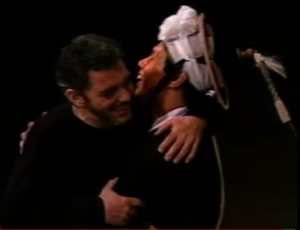
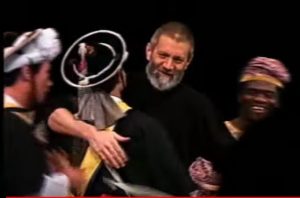
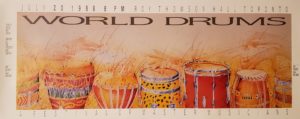 #NEXUSat50 1988 GLOBE-HOPPING PART TWO: BRITAIN AND CANADA The month of May took us to the U.K. and Percussion’88 where we performed with our good friends from Hungary, Amadinda. The Festival took place in London, Bristol and Cardiff. David Allenby of Magenta Music was the Administrative Director. Later that year David moved over to Boosey & Hawkes Publicity and Marketing in London where he has been ever since and is now Vice President. Other percussionists on the Percussion’88 roster were Kroumata, James Wood, Robyn Schulkowsky and Steve Schick. John Wyre was refining World Drums – There were 2 Canadian events with 22 performers: at the World Junior Championships when 1024 athletes from 123 countries descended on the northern city of Sudbury, and also at Roy Thomson Hall in Toronto. “…Ranging from the ritualistc…Kelaniya Free Lancers to the frankly downtown sounds of …Thigpen, Everyone had a different take on how to handle a piece of hide stretched over a cylinder…Adzenyah’s barrel drum could be made to change pitch at the squeeze of an elbow…Australis’s home-made mouth bow…seemed the very last word in born-again exoticism…which produced a truly amazing range of sounds.” (Globe & Mail). “Last night’s concert began…one by one…Trichy Sankaran…beating out the initial rhythms…[Australis] adding bowed and beaten rhythms…mallet wizard Bob Becker and the versatile Russell Hartenberge joined in…tabla virtuoso Pandit Sharda Sahai, the Ghanaian master drummer Abraham Adzenyah and legendary jazz drummer Ed Thigpen who took up his position…like the anchor man he was…Imagine how the sound changed when they were joined by African Heritage…a heavy beat from southern Africa, and Bomas pounding out the very different beat of Kenya. Cap their efforts with the strutting Sri Lankan drummers. ..This introductory exercise [titled Getting To Know You by Wyre] ended with a collective whoop from the audience…And if you’re wondering how a Gumboot Dance of the miners of South Africa, stomped out in a darkness pierced only by the lights on the dancers’ helmets managed to make sense in the company of Bob Becker’s breezy xylophone styling…don’t try. Just call it ecumenism.” (Toronto Star). Paula Citron in a feature article listed some of the instruments: “tammattama, davula, gamelan, atsimevu, krobitodsi, kayamba, mbira, darabuka, djimbe” and mentioned “African Heritage, the group from Vancouver made up of a South African, A Puerto Rican and two Los Angelenos, fills the stage with at least 20 different instruments.” The excellent poster for the RTH event is attached. Most of us have this one framed.
#NEXUSat50 1988 GLOBE-HOPPING PART TWO: BRITAIN AND CANADA The month of May took us to the U.K. and Percussion’88 where we performed with our good friends from Hungary, Amadinda. The Festival took place in London, Bristol and Cardiff. David Allenby of Magenta Music was the Administrative Director. Later that year David moved over to Boosey & Hawkes Publicity and Marketing in London where he has been ever since and is now Vice President. Other percussionists on the Percussion’88 roster were Kroumata, James Wood, Robyn Schulkowsky and Steve Schick. John Wyre was refining World Drums – There were 2 Canadian events with 22 performers: at the World Junior Championships when 1024 athletes from 123 countries descended on the northern city of Sudbury, and also at Roy Thomson Hall in Toronto. “…Ranging from the ritualistc…Kelaniya Free Lancers to the frankly downtown sounds of …Thigpen, Everyone had a different take on how to handle a piece of hide stretched over a cylinder…Adzenyah’s barrel drum could be made to change pitch at the squeeze of an elbow…Australis’s home-made mouth bow…seemed the very last word in born-again exoticism…which produced a truly amazing range of sounds.” (Globe & Mail). “Last night’s concert began…one by one…Trichy Sankaran…beating out the initial rhythms…[Australis] adding bowed and beaten rhythms…mallet wizard Bob Becker and the versatile Russell Hartenberge joined in…tabla virtuoso Pandit Sharda Sahai, the Ghanaian master drummer Abraham Adzenyah and legendary jazz drummer Ed Thigpen who took up his position…like the anchor man he was…Imagine how the sound changed when they were joined by African Heritage…a heavy beat from southern Africa, and Bomas pounding out the very different beat of Kenya. Cap their efforts with the strutting Sri Lankan drummers. ..This introductory exercise [titled Getting To Know You by Wyre] ended with a collective whoop from the audience…And if you’re wondering how a Gumboot Dance of the miners of South Africa, stomped out in a darkness pierced only by the lights on the dancers’ helmets managed to make sense in the company of Bob Becker’s breezy xylophone styling…don’t try. Just call it ecumenism.” (Toronto Star). Paula Citron in a feature article listed some of the instruments: “tammattama, davula, gamelan, atsimevu, krobitodsi, kayamba, mbira, darabuka, djimbe” and mentioned “African Heritage, the group from Vancouver made up of a South African, A Puerto Rican and two Los Angelenos, fills the stage with at least 20 different instruments.” The excellent poster for the RTH event is attached. Most of us have this one framed.
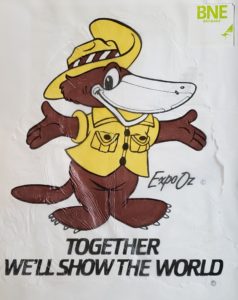 #NEXUSat50 1988 GLOBE-HOPPING PART 3: AUSTRALIA! Brisbane hosted a spirited and festive Expo 88 in August and a 90-musician World Drums was there. As was our now-manager Peggy Feltmate, assisting with producing Canada Pavilion entertainment & with company management for our following 25-musician coastal tour which took us northward up the Gold Coast, along the Great Barrier Reef to Cairns. One striking incident remains etched in Peggy’s (and all of our) memory — In the town of MacKay in its newly-opened concert hall, Trichy Sankaran abruptly “encountered” one of its crystal-clear glass walls with a resounding reverberating THONK! John Wyre tells the tale: As everyone came running, “Trichy rebounded and slowly staggered about…Realizing that Trichy was stunned but okay, Sal [Ferreras] suggested to Glen [Velez] and me that it might be a good time to play some music. Maybe the impact would slow Trichy down enough to allow us to stretch out a little more. It worked. Trichy’s notes-per-moment ratio fell dramatically and left a lot of room for us to express ourselves.” John tells another Australia story where Sharda Sahai and Trichy joined together “in a duet that was always an astonishing musical experience. The challenge …was keeping them within the allotted time so the concerts would be a reasonable length. I always introduced Sharda and Trichy as ‘These great masters from India.’ Invariably, their duet would be much longer than I’d planned…When I’d ask Trichy about this, he would reply that Sharda controlled the length of their dialogue. When I spoke with Sharda, he would tell me that Trichy was in charge of the duration. One evening in Gladstone, their duet was simply cosmic…[but] their 10-minute spot had lasted 25 minutes! I ran backstage to confront them together. Trichy saw the fire in my eyes and quietly said, ‘I am thinking the masters had a lot to say tonight.’” World Drums Expo88 brought in new faces too: Richard Walley’s newly-formed Middar Aboriginal Theatre with haunting didgeridoos. Australian Phil Treloar on drum set. Korea’s Kang Sun-Young dance Troupe featuring “a line of young women in traditional costume…each surrounded by 3 small round drums [who] gave a breath-taking display of timing…while each enclosed in their own small drumming shrines.“ They were interpreting a Buddhist Monk’s spiritual struggle. Indonesia’s Rampak Gendang – “more than a dozen young men with drums who conjured up images of a joyful carnival”; Japan’s Chichibu Shachu (11 drummers and 2 flute players) brought out their giant drums for a grand finale. Wonderful reviews – 2 of them referred to “John Wyre the live-wire” and called him “percussion’s answer to the plait-wearing Willie Nelson”! Photos: the glass walls of the Mackay Centre; And above, from the scrapbooks: Expo Oz the platypus (who was everywhere).
#NEXUSat50 1988 GLOBE-HOPPING PART 3: AUSTRALIA! Brisbane hosted a spirited and festive Expo 88 in August and a 90-musician World Drums was there. As was our now-manager Peggy Feltmate, assisting with producing Canada Pavilion entertainment & with company management for our following 25-musician coastal tour which took us northward up the Gold Coast, along the Great Barrier Reef to Cairns. One striking incident remains etched in Peggy’s (and all of our) memory — In the town of MacKay in its newly-opened concert hall, Trichy Sankaran abruptly “encountered” one of its crystal-clear glass walls with a resounding reverberating THONK! John Wyre tells the tale: As everyone came running, “Trichy rebounded and slowly staggered about…Realizing that Trichy was stunned but okay, Sal [Ferreras] suggested to Glen [Velez] and me that it might be a good time to play some music. Maybe the impact would slow Trichy down enough to allow us to stretch out a little more. It worked. Trichy’s notes-per-moment ratio fell dramatically and left a lot of room for us to express ourselves.” John tells another Australia story where Sharda Sahai and Trichy joined together “in a duet that was always an astonishing musical experience. The challenge …was keeping them within the allotted time so the concerts would be a reasonable length. I always introduced Sharda and Trichy as ‘These great masters from India.’ Invariably, their duet would be much longer than I’d planned…When I’d ask Trichy about this, he would reply that Sharda controlled the length of their dialogue. When I spoke with Sharda, he would tell me that Trichy was in charge of the duration. One evening in Gladstone, their duet was simply cosmic…[but] their 10-minute spot had lasted 25 minutes! I ran backstage to confront them together. Trichy saw the fire in my eyes and quietly said, ‘I am thinking the masters had a lot to say tonight.’” World Drums Expo88 brought in new faces too: Richard Walley’s newly-formed Middar Aboriginal Theatre with haunting didgeridoos. Australian Phil Treloar on drum set. Korea’s Kang Sun-Young dance Troupe featuring “a line of young women in traditional costume…each surrounded by 3 small round drums [who] gave a breath-taking display of timing…while each enclosed in their own small drumming shrines.“ They were interpreting a Buddhist Monk’s spiritual struggle. Indonesia’s Rampak Gendang – “more than a dozen young men with drums who conjured up images of a joyful carnival”; Japan’s Chichibu Shachu (11 drummers and 2 flute players) brought out their giant drums for a grand finale. Wonderful reviews – 2 of them referred to “John Wyre the live-wire” and called him “percussion’s answer to the plait-wearing Willie Nelson”! Photos: the glass walls of the Mackay Centre; And above, from the scrapbooks: Expo Oz the platypus (who was everywhere).
